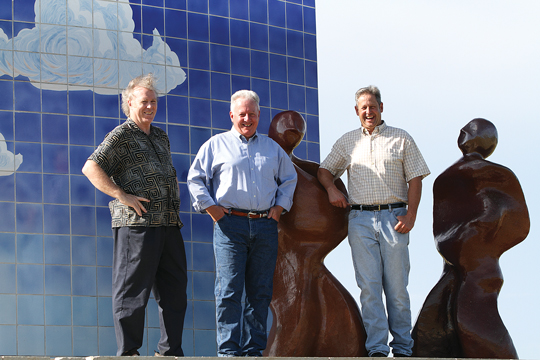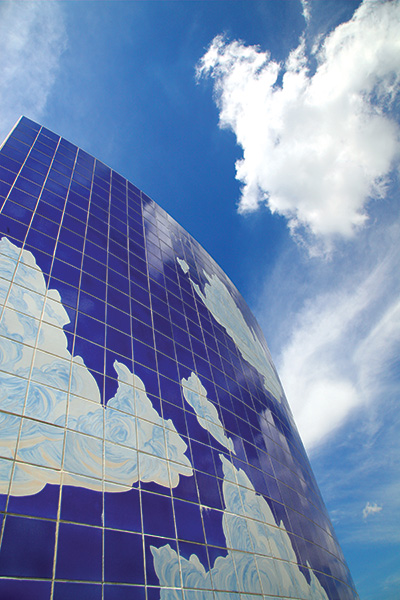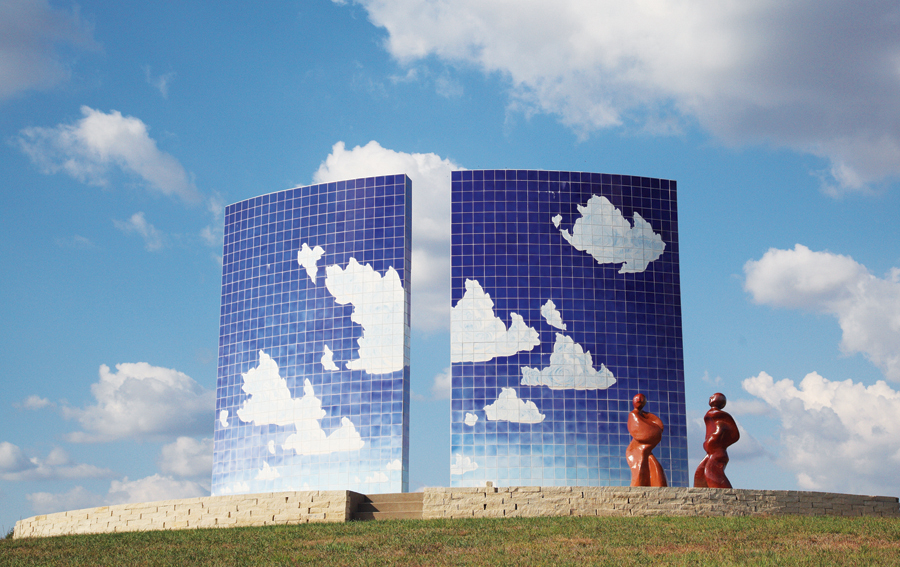The following is a slightly edited version of Phil Epp's own words in describing how to view the sculpture. The complete version of these tips appeared in the 11-05-02 Newton Kansan.
 Viewing the sculpture from a distance
Viewing the sculpture from a distanceThe most striking feature of the Blue Sky Sculpture is the vivid intensity of the blue in the glazed tile. The non-fading gem-like surface quality can appear like a sapphire mirage at predawn, and later glisten with the pinks and golds of sunrise. The colors appear most fluid and transparent during midday sunlight and more intense on overcast days and in the early evening hours. The majestic cobalt glaze is similar to the glazes first used by the Chinese around 1325 AD. The large area of luminous blue in contrast with the white clouds and the life-size stoneware figures makes this a unique work of art.
Looking at Blue Sky from the viewing pad
The tile sky motif is intended to heighten the viewer's awareness of the changing Kansas sky. On an active weather day, three perspectives may be observed simultaneously: The natural sky can be viewed behind the glazed tiles and through the sky passageway. It can also be seen reflected in the shiny surface of the tile. The hand-painted and hand-installed tiles have a slight variation that causes light to shimmer and flicker on the liquid surface. The sun movement from east to west along the arched surface will change the color and intensity at different times of the day. The night lighting is intended to illuminate the cloud surface and fade into the natural night sky.
Viewing from the sculpture stage

Close-up viewers are encouraged to touch the tactile ceramic surfaces and look up. The massive arced walls are designed to accentuate the distant perspective and to be in rhythm with the rolling landscape. The warm sunlight on a winter day makes the south side of the towers a pleasant area reminiscent of a prairie windbreak. The sculpture participant is encouraged to stand in the sky passageway. This "heart of the sculpture experience" is intended to enhance the viewer's observance of the surrounding sky and take a leading role in the visual drama.
The figures
 The stoneware figures encourage interaction between the sculpture and the viewer. The sturdy, thick walled figures require six months to dry and are fired twice for eight days at a temperature of 2290 degrees Fahrenheit. The Shino glaze with rich, dark accents from iron oxide has been used for centuries by both Chinese and Japanese ceramists. The figures are intentionally abstract so that the observer can assign them individual activity and identity.
The stoneware figures encourage interaction between the sculpture and the viewer. The sturdy, thick walled figures require six months to dry and are fired twice for eight days at a temperature of 2290 degrees Fahrenheit. The Shino glaze with rich, dark accents from iron oxide has been used for centuries by both Chinese and Japanese ceramists. The figures are intentionally abstract so that the observer can assign them individual activity and identity.
Location: 12th and Kansas, go east at Dillon's to Centennial Park.
E-mail: pepp@powwwer.net
Hours and admission fee: Always open, no fee.
 Viewing the sculpture from a distance
Viewing the sculpture from a distance
 The stoneware figures encourage interaction between the sculpture and the viewer. The sturdy, thick walled figures require six months to dry and are fired twice for eight days at a temperature of 2290 degrees Fahrenheit. The Shino glaze with rich, dark accents from iron oxide has been used for centuries by both Chinese and Japanese ceramists. The figures are intentionally abstract so that the observer can assign them individual activity and identity.
The stoneware figures encourage interaction between the sculpture and the viewer. The sturdy, thick walled figures require six months to dry and are fired twice for eight days at a temperature of 2290 degrees Fahrenheit. The Shino glaze with rich, dark accents from iron oxide has been used for centuries by both Chinese and Japanese ceramists. The figures are intentionally abstract so that the observer can assign them individual activity and identity.